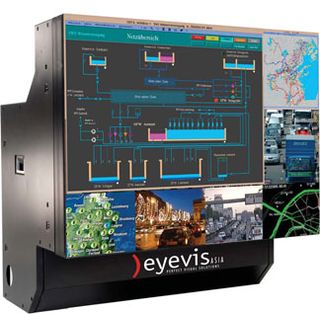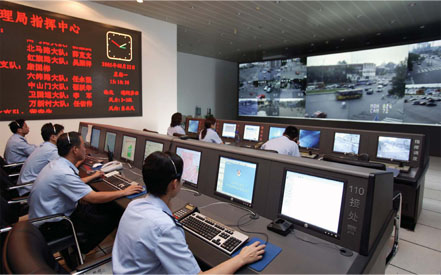Huge Investments In Infrastructure, And The Pressing Need To Secure Those Investments, Are Driving Asia’s Market For Command And Control
According to a report published recently by Frost & Sullivan, mounting security concerns in the Asia Pacific region have seen the security camera market experience tremendous growth: the company forecasts a CAGR of 17.9 percent in the years to 2013. “Recent terror attacks have increased security awareness among government and organizations across the world, prompting increasing spending on surveillance,” notes Frost & Sullivan Research Analyst Wong Weng Yew.
“Building and transportation hubs have become prime terror targets, and video surveillance has become a popular security tool, particularly with the advanced digital technology— that is, IP surveillance.” The company followed up its report in July when its Singapore-based Smart Card & Auto ID practice for Asia Pacific hosted an analyst briefing—‘Significant Trends in Video Surveillance’— via webinar.
Here are just two examples. In June, Honeywell participated in the 2008 Global Gaming Expo G2E Asia in Macau to showcase the company’s integrated digital surveillance solutions for casinos— solutions that include intelligent video analytics and networked video recording. And next year’s ‘must attend’ event for professionals in the security, surveillance and monitoring market in Asia looks as if it will be ‘Safety & Security Asia 2009’, planned for the Suntec Singapore International Convention & Exhibition Centre in October.
Earlier this year, ADT CAPS, the Asian division of the global security and fire detection manufacturer and service provider, announced that it had signed its 300,000th customer. The significance of that event was that it took the company 16 years to achieve 100,000 customers—but only four years to secure the next 100,000, and less than four years to achieve the next 100,000…
The growth can be attributed in part to the fact that Asia-Pacific is still a relatively young market—a point made by Stanley Lai, Director of Eyevis Asia. While youth creates opportunities, it also creates challenges, at least in the control room market served by Eyevis with its range of screens.
“Eyevis Asia started operations three to four years ago,” Lai says. “Our business has been growing steadily ever since. We feel that the command-control and security market is still in its infancy in Asia, unlike in Europe and the USA, where the implementation of such systems by governments as well as private institutions is much more widespread.”
THE TROUBLE WITH YOUTH
On the downside, Lai says his company is seeing customers “rush into implementing command and control systems—often in response to a crisis—and that can mean that they don’t undertake the necessary consultation and planning.” Lai says this is especially true in the area of ensuring that the operators, on whom the system’s success depends, have an ergonomically suitable environment.
“The market is definitely growing,” rejoins Wing-Shing Leung, Business Development Manager for Asia at Barco, “albeit at a slower rate in China than was the case in the run-up to the Beijing Olympics, which really fuelled demand for security and control room solutions in traffic and surveillance.”
Other companies are seeing similar growth in the region. “The rapidly expanding industrial infrastructure in the world’s developing economies—places like South-East Asia, India, and China—means that there is significant, and ever-increasing, demand for command/control and security technologies, either as new build projects or as part of the refurbishment of existing facilities,” says Toshihiro Takaichi, Manager of Business Development (Control Rooms) at Mitsubishi. “But this industrial development is also driving urban growth, which in turn means increased demand from the utility and transportation sectors.”

Throughout Asia, demand for control room products such as Eyevis rear-projection cubes has begun to increase. is still in its infancy, we would normally expect that the fastest-growing segment would be with governmental organisations,” notes Stanley Lai. “That’s why we’re seeing the most significant opportunities in applications such as defence, infrastructure, utilities, and power— because these are typically government- run.
“What we’re also seeing is that protection against terrorism and natural disaster are of great importance as each country tries to equip itself with the most sophisticated solutions possible to counter terrorism, as well as to provide the earliest warning against natural disaster.”
Wing-Shing Leung agrees, saying his company is seeing an upward trend in the requirement for systems in homeland security, disaster management and traffic management, with a focus on terrorism and crime. “After the tsunami,” he adds, “Thailand, Indonesia and Malaysia have been in the forefront of installing systems designed to help forewarn of, and cope with, potential climatic disasters. Beyond that, new opportunities are beginning to appear in areas as diverse as university campuses, theme parks and casinos.”
IP CAMERAS POINT THE WAY
Specifically, the Frost & Sullivan report noted above indicates a belief that it will be the growing availability of affordable, increasingly functional, and increasingly interoperable IP cameras—and improved understanding of the benefits they bring—that will continue to fuel growth in the market. The report notes, though, that analog cameras have been widely installed throughout the region, and there is some resistance to be overcome if IP-based data capture and processing systems are to prevail.
Certainly, IP is no less a key enabler in Asia than it is in other markets— not least because the size of individual countries means that data may need to travel some distance from its capture location to the point at which it is monitored.
“Remote monitoring is a major trend in the Asia Pacific region,” notes Wing-Shing Leung. “Many installations or locations need to be monitored where no human operators are present. To this end, camera images are fed through an IP network and the streaming video is visualized in the master control room, from where a response can, if necessary, be co-ordinated.” As an example, he points to the construction of new railways, where the complete track is being laid with fiber-optic cabling alongside so that any sensor or camera can be IP-linked to the control room.
Using digital technology to capture, process, and store images gives rise to benefits beyond the ability to move them long distances over existing highspeed networks—and allows Asian companies to leverage technologies that are only just becoming available in more developed markets. With so many sources to monitor, human operators are in danger of being overwhelmed and, increasingly, are turning to digital technology to help them. Michael Sleijster is Business Development Manager for Observision, a Dutch manufacturer that is a sister company of Singapore’s Isolectra—both are part of the TKH Group, with Isolectra bringing Observision’s products to the Asian market.
“One of the reasons for the fast growth of the command/control and security market is the rapidly developing understanding of what can be done to automatically analyse video,” says Sleijster. “Our XTRACT hardware and software platform provides a solution for high-quality video content analysis, while our VideoMiner allows for post-analysis of stored video.” He goes on to explain that video content analysis allows ‘unusual’ events, objects, or movements to be automatically identified and highlighted to the operator, while the VideoMiner allows recorded video to be searched for specific objects or movements at up to 5,000x real time.
KEEPING CONTROL OF COSTS
According to Mitsubishi, however, it’s not just about pure performance. As customers become more sophisticated, they’re looking further. “Along with our display products, Mitsubishi Electric is one of the world’s largest engineering businesses, involved in many large-scale capital projects such as power stations, electricity substations, turbines, and automated factories,” notes Toshihiro Takaichi. “This gives us a special understanding of the factors that are important to these markets; in particular, product reliability and low cost of ownership. With digital display devices, product reliability is our key in achieving low cost of ownership, giving customers greater up-time, less maintenance, and lower cost of operations.”
Takaichi points out that Mitsubishi has now shipped 30,000 display products worldwide that feature technologies such as dynamic brightness balancing, color space control, ‘Smart Lamp’, ‘Smart Colour Wheel’, and digital gradation. He also notes that Mitsubishi has recently launched an 80-inch SXGA+ display wall cube into the Asian market, allowing large displays at lower cost and complexity.
At Barco, new products include the SVC2 streaming video card which, says the company, gives even greater flexibility and interoperability, while the CMS Control-room Management Suite supports visualization solutions for live collaboration using real-time video, data, and graphics sources shared over the network.
Observision is working on audio analysis technology to complement the company’s video analysis capability, while VideoStabilizer (which compensates for images blurred by a camera made unsteady by high winds, for example) and AlarmView (a web-based camera monitoring system for small and medium-sized enterprises) have been launched to run on the company’s XTRACT processor.
processor. If the Asian market for security and command/control solutions has shown good growth up until now, how does the industry see the future? Stanley Lai sees “only growth” for the next 20 years, while Wing-Shing Leung notes: “The region is characterized by long-running projects. For instance, in city surveillance and transportation, those projects can take between three and five years to complete. So in the short term, we don’t expect many changes in the command- control and security market. One thing is for sure, though: visualization is gaining more and more in importance all the time.”
“We expect to see business in command-control and security markets increasing over the coming year,” adds Toshihiro Takaichi, “and indeed over the next five years. The demand from developing and emergent economies continues to grow.”
While still in its infancy, the Asian market for integrated security solutions is showing signs that high growth rates can be sustained, not least because of the unique characteristics of the region’s countries. IP looks as if it can be the technology that supports this growth, as Asian organizations take advantage of the learning curve that their western counterparts have been through. And as the region focuses on building out the infrastructure necessary to support its rapidly growing economic importance, it’s hard to see anything other than good times for manufacturers and well-prepared integrators alike.
Ian McMurray was European Marketing Manager for the DLP division of Texas Instruments from 1996 to 2003. He now writes regularly for a number of AV industry publications.










